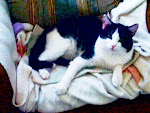"Unsung heroes kept shuttle flying"
by
Traci Watson
July 6th, 2011
USA TODAY
by
Traci Watson
July 6th, 2011
USA TODAY
Atlantis, scheduled for launch Friday, is powered by the labor of thousands. Welders and engineers, trainers and seamstresses have dedicated their lives to the shuttle, which made its first flight 30 years ago. The four astronauts aboard Atlantis for this final, bittersweet voyage will get the accolades, but they're only the most visible custodians of a spacecraft built and tended by an army of people across the nation.
"It's not about us," Atlantis astronaut Douglas Hurley said last month. "We ought to be celebrating the folks who worked an entire career to make these vehicles go into space safely and bring us back safely."
Just six years ago, more than 17,000 people worked for the shuttle program. Within a month of Atlantis's final return to Earth, planned for July 20, the latest in a series of layoffs will cut the staff to about 1,000. NASA has no new rocket to fly, so there is no need for all those workers.
So Craig Capdepon no longer will get to carefully spray insulating foam in every crevice around the fuel tank. Lisa Martignetti won't be able to prepare crews for possible disasters. Bob Myers, a driver of the giant crawler that brings the 4.5-million-pound shuttle to the launch pad, and engineer Howard Law, hope to work on a new vehicle.
But for Toni Peterson, who helped the astronauts with their spacesuits, and Henry Diaz, who helped build the booster rockets, the pride of watching the last shuttle launch is mixed with the pressing need to find a new job.
The lack of a successor to the shuttle means "we are losing this marvelous workforce, with their incredible, singular, and unique skills," former shuttle boss Wayne Hale says. "When the day comes when we need these capabilities again, it will be very difficult and costly to re-create what is being disbanded right now."
Recounting the lives and careers of six people who worked on the shuttle can not completely represent the thousands that astronaut Hurley suggests celebrating. But it's a start.
Craig Capdepon, Fuel-tank builder
Every one of the fuel tanks the shuttle has carried to space during the 134 launches bore the craftsmanship of Craig Capdepon.
In 1978, Capdepon had plans to finish an English degree when friends talked him into a summer job working on the shuttle's fuel tank instead at the Michoud Assembly Facility in New Orleans. Three years before the shuttle's maiden flight, NASA had not yet figured out the best procedures for coating the tank with foam insulation. The challenge of figuring out how to insulate the tank persuaded Capdepon to abandon his course work.
"I just got so interested in what was going on out here," says Capdepon, now 55. "It was … a lot of trial and error to get the process correct."
Capdepon went on to specialize in the tricky job of hand-spraying foam onto pipes, struts and other pieces of the tank. Under the eyes of a spotter, a quality-control inspector and a host of engineers, he sprayed foam from a giant gun in the confines of a cramped and steaming-hot "spray booth."
His group's pre-spray ritual reflected their seriousness. "We would ask the Lord's blessing on what we did and the work of our hands," he says. "We always did the very best we could."
During shuttle launches, he kept his eye on the tank until it fell off the shuttle and burned up in the atmosphere, as it is designed to do. He watched partly to make sure the tank performed as it should, mindful that foam debris from the tank fatally damaged shuttle Columbia in 2003. But he also watched to see the tank he helped build take its star turn. "I can hardly explain the feeling we had watching a launch," he says. "It's a very proud moment."
Now those moments of pride — pride in his handiwork, his colleagues, his country — are ending.
Many of his co-workers at Michoud have been laid off. Capdepon, who is married and has seven children, doesn't know whether his job will survive. He plans to stay with Lockheed Martin, which runs the tank plant, as long as he can.
Working on the shuttle "has just been incredible," he says. "I'm just very glad I was able to be part of it."
Lisa Martignetti, Simulation Supervisor
Lisa Martignetti's job is to put astronauts under major stress.
As a "sim sup," or simulation supervisor, Martignetti spends most of her time leading rehearsals of shuttle launches and landings, the most dangerous phases of a flight. Throughout the rehearsals, Martignetti and her staff pelt the astronauts and flight controllers with virtual malfunctions that test their knowledge and teamwork to the breaking point.
"We hurt them for their own good," she says laughingly. "By the time we get to the end of the training flow … they're ready to go — at least if I do my job well."
Martignetti, 47, has schooled flight crews and controllers at NASA's Johnson Space Center in Houston since 1989. After 22 years, her enthusiasm is undimmed. "I love getting up in the morning and coming to work," says Martignetti, who has an engineering degree from the Air Force Academy. "I like keeping the astronauts safe by making sure they know what they're supposed to do."
The punishing simulations proved their worth in 2009, when a component that helps control the shuttle's steering mechanisms failed during launch. The crew and flight controllers "handled it perfectly," Martignetti says, even reporting afterward that the incident "felt like a training exercise, but easier."
The last shuttle-mission simulation was held Friday. Martignetti and her staffers got notice from their employer, contractor United Space Alliance, months ago, but nearly all chose to see the shuttle program to the end. Martignetti herself won't start job-hunting until the final flight has landed safely.
"Nobody's performance level or dedication has changed at all," says Martignetti, her eyes filling with tears. "All these people who know it's going to be their last sim are excited about it. … I'm just so proud of everybody that I work with."
Though she's "heartbroken" over the end of the shuttle and the dissolution of her staff, she does not regret devoting her career to the shuttle.
"If I could go back in time and do it over, I would do the same things so I could be here for 22 years," she says. "It's been a great ride."
Bob Myers, Crawler engineer
At home, Bob Myers likes to tinker on vintage muscle cars. At work, he tinkers on another vintage vehicle: the crawler-transporter, the gargantuan 1960s-era machine that carries the orbiter, fuel tank and booster rockets from the hangar to the launch pad.
Myers, 57, is one of six crawler drivers, the elite engineers who not only keep NASA's pair of crawlers in good working order, but also drive them. For Myers, the job is fun and privilege combined.
There's "a great sense of pride in carrying the shuttle out to the pad, because it's America's shuttle," he says. "It's not just ours."
With a speedometer that goes from 0 to 2 mph, the crawler won't win any races. But it is exquisitely precise, capable of moving as little as an eighth of an inch on command. After 28 years behind the wheel, Myers has developed a sixth sense that lets him nudge the crawler to within half an inch of its target at the launch pad.
"There's nothing like docking it," he says. "That's my favorite part, because it requires all of your skill. It's a challenge every time."
Besides driving the crawlers, Myers helps bring the Apollo-era vehicles into the 21st century. He and his colleagues recently gave the crawlers a new set of "shoes," the enormous slats that make up the treads, and they've replaced its printed circuit cards with modern software.
Last month, Myers finessed a shuttle-laden crawler to a docking with the launch pad one final time. He's convinced the crawler has a future carrying other rockets. He's less certain of his own future. He hopes to stay with United Space Alliance, his employer at NASA's Kennedy Space Center in Florida, long enough to adapt the crawler to America's next spaceship.
"The shuttle's all I've ever known," says Myers, who is married and has five children. Once it's gone, he'll miss "all the celebration that goes with putting the shuttle on the pad. … We'll miss that, there's no doubt about that. And until we have something else to replace it, it'll just be a memory."
Howard Law, Engineer
As he guides a simulated version of the space shuttle to a stop on a virtual runway, aerospace engineer Howard Law is having the time of his life.
"Whoaaa!" he exclaims, laughing, as he tries to straighten the spacecraft's nose. "Can't talk and fly at the same time."
Law, 63, helps write the equations used in the software that controls the spacecraft's movements as it plunges to Earth and touches down on the runway. The software is then tested in NASA's shuttle-engineering simulator, a life-sized facsimile of the shuttle's flight deck complete with digitally generated landscapes visible through the windows.
Sitting in the commander's seat, Law puts the simulator through a half-dozen mock touchdowns while running through a rapid-fire description of the changes he and his colleagues have made to the shuttle's landing equipment. For every enhancement of the hardware, such as better brakes or a new parachute, Law adjusted software equations to ensure the astronauts could still handle the vehicle.
Early in the shuttle's history, "we had one person who basically touched it down just above tail scrape, and we had another person who touched it down at the max tire speed," says Law, who started at NASA's Johnson Space Center in Houston in 1973. "Today that doesn't happen … partly because of the improvements we made to the vehicle."
Law takes pleasure in the challenge of perfecting a demanding and delicate spacecraft, and in the mix of math and consultation with astronauts that his job entails. "This is my avocation and my vocation," say Law, who flies gliders on the weekends.
As a civil servant, Law, who is married with three grown children, is likely to keep his job, perhaps helping with NASA's next spacecraft. After pouring more than three decades of his life into the shuttle, he has complicated feelings about its demise. He admires its capabilities, yet he is convinced something better awaits. "My whole life has been tied up with this vehicle, and there's a certain sadness when things come to an end," he says. "But there's also a certain recognition that it's time to grow up and move on."
Toni Peterson, Spacesuit technician
Fourteen years after landing a job as a spacesuit technician, Toni Peterson still seems awed by her good fortune.
Before NASA, she had tended bar, worked in an office and on broken down cars in a body shop. When she heard about the job, she called the recruiters regularly for six months until they finally hired her.
"I thought it would be really fun and neat," she says to explain her persistence. "I didn't have any idea it would be traveling and working with astronauts … Working with the astronauts has been the most exciting and neatest thing that I could have ever imagined that I'd be able to do."
Peterson, 50, looks after the "pumpkin suits," the orange coveralls astronauts wear during shuttle launches and landings. If the shuttle's cabin depressurized, the airflow in the crew's suits and helmets would keep them alive.
In a role she considers "an honor," Peterson tests and cares for the suits near NASA's Johnson Space Center in Houston. On launch day, she's usually at Cape Canaveral, helping the astronauts don the cumbersome outfits. She's among the last people to speak with the crew before liftoff.
She confesses that the suit-up ritual, in the storied "suit-up room," makes her nervous. "There're so many people in there, and all the cameras, and you want your crewmember to be comfortable and feel secure and know that everything is the way it should be," she says. She tries to take care of her astronauts, and they take care of her. She treasures the mementos they've taken into space for her - the pendant that spent six months on the International Space Station and the patches bearing her name.
Peterson, who has a grown daughter, has already gotten a pink slip from her employer, United Space Alliance. She hopes to become a flight attendant so she can indulge her love of traveling, but she knows her next job may not offer as much adventure as her current position.
"God has been very gracious," she says. "This one's going to be hard to top."
Henry Diaz, Rocket-booster builder
Clocking shifts in a furniture factory, Henry Diaz dreamed of working in the space business. When he got his chance in 2003, he made the most of it. His new job making the shuttle's rocket boosters "became my joy," says Diaz, 39. "Knowing that the ultimate purpose was a space-shuttle launch, I dedicated myself to learning as much as I could."
At the bottom of the 50-foot-deep "casting pit," he set up the piping that channeled the viscous fuel into the rocket shells. He learned to drive the 200-ton crane that swung equipment into the pit. He built the rocket's arming device, the explosive charge that lights the rockets just before liftoff. Watching a rocket fire during a launch, "you knew it ignited because you built the part that actually started that," he says.
Diaz and his co-workers never forgot the danger posed by the rockets, which were responsible for the 1986 loss of shuttle Challenger and her crew. "We would do everything the way we did because ultimately there are human lives that are going to be sitting on top of those things," he says. "We were willing to do all this training and oversight and everything for that cause."
At first, news of the shuttle's retirement didn't alarm Diaz and his colleagues.
Their bosses at rocket manufacturer ATK were confident that NASA's next spaceship would also require rocket boosters, which would keep the Promontory, Utah, rocket factory busy. But the efforts to develop a new spaceship floundered.
Gradually the rocket team ran out of work. Diaz got laid off in mid-2010. After returning to school to get certified as an industrial maintenance mechanic, he is now job-hunting and taking more classes. Diaz, who is married and has four daughters, will monitor Atlantis' liftoff, but he doesn't expect to savor the experience as he once did.
After the layoff, shuttle launches became "more painful to watch, because it was a reminder of what I wasn't a part of anymore," he says.
The final launch "will be tough. … The space shuttle was a wonderful vehicle, more than I could even know."





























!["Coupling" 1976 [Gum-bichromate]](http://2.bp.blogspot.com/_IoU3bEFUwWc/S69lnr9G6AI/AAAAAAAAH58/O40Gg-G6rKk/S150/COUPLING+3.jpg)








No comments:
Post a Comment